I would say there is a distinction between number of blends available and number available to an individual. In the 70s, I could go into a newsstand or drug store and probably find a dozen or more blends. In a well-stocked tobacconist, probably 40 or 50 blends. I suspect that there were thousands on the market, but many were not represented in any particular market area.
Random Question: History of Pipe Tobacco in the U.S.
- Thread starter EvertonFC
- Start date
You are using an out of date browser. It may not display this or other websites correctly.
You should upgrade or use an alternative browser.
You should upgrade or use an alternative browser.
SmokingPipes.com Updates
Watch for Updates Twice a Week
That’s an impossible question to answer. Different things matter to different people.I've heard often that we're living in a golden age of pipe tobaccos, in terms of options and blends. So my question is this; during the golden age of pipe smoking in the U.S., what was the selection like? Were there 1,000s of blends? Hundreds? Dozens? Does anyone have some idea of what sort of variety was available? Thanks in advance.
When I first took up the pipe in the early ’70’s the overall quality of pipe tobacco was higher than it is today.
Dunhill tobacco was made by Dunhill. Rattray’s was made by Rattray’s. Escudo was made by Gallhers. Sobranie Ltd produced Balkan Sobranie, 759, the Garfinkle blends, etc. British tobaccos were made by the companies that had been around for decades.
There were hundreds of highly skilled tobacconists blending very high quality tobaccos, making custom blends for their clientele and selling their products nationally.
Most of that is long gone, replaced by conglomerates who bought up multiple IPs, and turn out clones of those once celebrated blends.
We may have more labels available, but the individuality is gone. The quality of leaf is more mixed. That’s not to say that excellent blends aren’t available today, but the overall quality has slipped.
All that said, people who never experienced what pipe tobaccos were like will form their standards on what is available today and may be very happy with the choices they have.
So the perception of a “golden age” is very much the product of individual experience.
Point well taken.I would say there is a distinction between number of blends available and number available to an individual. In the 70s, I could go into a newsstand or drug store and probably find a dozen or more blends. In a well-stocked tobacconist, probably 40 or 50 blends. I suspect that there were thousands on the market, but many were not represented in any particular market area.
There may be more blends today, but many have them have been purchased by other companies and are being made in different countries than they were originally. England at one time had very strict laws in what you could add to tobacco which was why not many aromatic blends originated in England in that time period. Sweden, Denmark, Germany and Holland had different laws and were able to add more sugar and sweetness to blends then the English.
But the buying and selling a brand names has been going on for years. I have a book with Imperial Tobacco advertising art that has in it an ad for Capstan from the late 1800s. It's two sourdoughs in the Yukon, both smoking pipes and one of them holding a can of Will's Captain. The other one holds out a handful of gold nuggets and the caption reads,"I will give you this handful of nuggets for that last can of Will's Capstan."
At some point, Imperial Tobacco purchased he rights to the name and I'm assuming the blend as well. I'm imagine the Capstan I loved in the 1980s it was different than the Capstan purchased in the 1890s.
Just as I can notice subtle differences between the Capstan blue I get today made by Mac Barens, but it is close enough that I smoke it on a regular basis.
As for how many Blends were available in the 1970s and 1980s, I really don't know but there were at least hundreds available in the US. That's a lot of inventory to stock unless you have a large mail order clientele. The advent of the internet and online ordering has no doubt increased the demand for some of these rarely seen blends, enough that a company with a large mail order business could afford to stock them. That was not the case when I was managing three stores in Oregon in the 1980s and early 90s. We had probably 40 bulk tobaccos, primarily Lane Limited, Peter Stokkebye, and McClelland. There were other producers of bulk tobacco that were less expensive, but even when we tried them unlimited basis they were not popular sellers. In addition to the bulk tobaccos we carried probably 25 or 30 facings of American tinned or pouched tobaccos and probably 40 facings of imported tins. In our smaller stores we carried fewer of the imported tins because they didn't sell as well, and if we had a customer who wanted some an inner store transfer was very easy.
I believe the internet has substantially changed the tobacco consuming habits of pipe smokers and with local taxes, it is very difficult for the local small B&M store to stock even as much tinned tobacco as we did. Many of them have high local taxes and cannot match the price available on the internet. But when I am traveling I enjoy visiting local pipe shops and talking to the Proprietors. I met one gentleman and Anchorage who had been in the tobacco business since he was a young man and he was probably in his sixties now. We had a very interesting discussion about what used to be, and what is now. It would be very difficult to do the kind of volume sales we did in the 1980s given the current market situation. And the delightful new companies that have arrived on the scene since then like Cornell and Dietz, Newminster, have added some very delightful blends to my cellar. And while I miss the presence of McClelland tobacco's I am delighted to see that Stokkebye has some nice Virginia flake and va/pr blends.
It has been said that the only constant is change, and that seems to be the case or the pipe and pipe tobacco industry, but for the most part, I think I can live and thrive with the changes.
I do remember mail order. But back in 80s, I didn't smoke pipe. I remember mail orders being painfully slow. Internet did change a lot of things.
Did I? Apologies. If any clarity is required, what I was trying to get at is this... when pipes were at their most popular (I'm assuming the '50s & 60s), what sort of tobaccos were available? Hope that clears it up. That said, thanks for your reply.Everton, you switch tenses in your original post. I think your golden age of the past was the 1950's and 1960's, and your golden age in terms of blenders, blends, variety, and cuts is today.
From what I understand, that began the "golden age" of tobaccos. What I'm curious about is, when the pipe itself was at its most popular, what sort of selection of tobaccos did that very large audience of pipe smokers have available? Cheers.I would argue that the Golden Age started with the internet and online sales
I would count that as 1, because I'm mostly curious about choices.The world will never know because 1 popular blend could be called 200 different names across many shops around the world. Do you count that as 200 “different” blends or 1?
I'm perfectly fine with that definition. And I too put far more trust in a man who smokes a pipe, compared to the no-good hooligans who smoke cigarettes.I would define the Golden Age of Pipe Smoking, when it was readily accepted in society, as World War II through the late 1980s. It was not uncommon to find a magazine article that published survey saying that women trusted men more who smoked a pipe that those who smoked cigarettes.
I wouldn't have guessed it was that high. Thanks.As for how many Blends were available in the 1970s and 1980s, I really don't know but there were at least hundreds available in the US.
You can decide Golden Age to be whenever you like. If you select the 50's and 60's most folks were smoking SWR, PA, and other drug store brands. Not that there weren't other more mature tobaccos to smoke.
there were literally thousands of tobaccos, pipes, and accessories being sold by catalogue.I would argue that the Golden Age started with the internet and online sales
Prior to that you were limited to what was stocked at the B&Ms and outlets like gas stations and supermarts which would have a rather limited selection of OTCs
Although I have never worked at a Tender Box pipe store, I think they were pivotal in raising the popularity of pipe smoking. Ed Kolpan (sp?) founded the first Tinderbox store 1928 in Santa Monica California. He was known as the tobacconist to the Stars. He franchised his first store in 1959. By the time I started smoking pipes in the 1970s and on into the 1990s The Tinderbox stores were not only widespread, their success was copied by many independent store owners. I even know of Tinderbox franchisees who would open up independent stores because many felt the franchise fees for The Tender Box stores was too high. I know of at least two different Tender Box franchisees who opened independent stores around the Portland Oregon metro area. And both of them open multiple locations. It's my belief that the popularity of The Tinderbox stores had a great spin-off effect and spawned many more stores that the Tinder Box franchise stores.
At least as far as the Pacific Northwest goes, I would say the 1970s through the early 1990s was the Golden Age of Pipe Shops. The plethora of pipe shops had a definite effect on pipe smokers as they were introduced to higher quality pipes than were readily available at the drug stores and also to a better selection and better quality of tobaccos. In the 1980s and early 1990s we had a lot of young men who would come in and try a pipe for the first time. I trained my sales staff to spend time with these new customers, answer their questions and encourage them to come back frequently to try a new tobacco. We were able to build a a strong, young customer base, as well as educating and upgrading our older pipe smokers. I personally enjoyed the interaction I had with my customers, (at least 98% of them) and look forward to visiting with them when they came in the store if I was not super busy. I made many good friends from my customers and we shared the camaraderie of pipes for many years. Now that I am retired and still live in Oregon, I occasionally run into some of my old customers. That's always a pleasant experience.
I think when it comes to, The Golden Age of pipes, pipe tobaccos, pipe stores and pipe smoking each of these Golden Ages may be spread a little differently on the timeline, but I have no doubt one has effect on the other. The Golden Age of pipe smoking help give rise to the Golden Age of pipe stores which in turn affected the demand for more and higher quality pipes. That was a natural function of a more educated and sophisticated population of smokers.
I have a tendency to agree though, that the popularity of the internet has brought about the Golden Age of Pipe Tobacco. I think we are enjoying that Golden Age right now, at least as it translates into more tobacco blends available and the ease of access we have through the internet.
At least as far as the Pacific Northwest goes, I would say the 1970s through the early 1990s was the Golden Age of Pipe Shops. The plethora of pipe shops had a definite effect on pipe smokers as they were introduced to higher quality pipes than were readily available at the drug stores and also to a better selection and better quality of tobaccos. In the 1980s and early 1990s we had a lot of young men who would come in and try a pipe for the first time. I trained my sales staff to spend time with these new customers, answer their questions and encourage them to come back frequently to try a new tobacco. We were able to build a a strong, young customer base, as well as educating and upgrading our older pipe smokers. I personally enjoyed the interaction I had with my customers, (at least 98% of them) and look forward to visiting with them when they came in the store if I was not super busy. I made many good friends from my customers and we shared the camaraderie of pipes for many years. Now that I am retired and still live in Oregon, I occasionally run into some of my old customers. That's always a pleasant experience.
I think when it comes to, The Golden Age of pipes, pipe tobaccos, pipe stores and pipe smoking each of these Golden Ages may be spread a little differently on the timeline, but I have no doubt one has effect on the other. The Golden Age of pipe smoking help give rise to the Golden Age of pipe stores which in turn affected the demand for more and higher quality pipes. That was a natural function of a more educated and sophisticated population of smokers.
I have a tendency to agree though, that the popularity of the internet has brought about the Golden Age of Pipe Tobacco. I think we are enjoying that Golden Age right now, at least as it translates into more tobacco blends available and the ease of access we have through the internet.
From what I've heard location mattered more. I also have heard that even a semi small town had a decent chance of having a tobacconist. One thing that I find laughable is that people think (including myself if I don't stop and think about it.) that there was as much a type of pipe smoker that was uniform, which seems as insane as doing the same thing now. I bet it was more similar aside from the obvious as it is now. I bet some guys rotated through blends and Granger only smokers. Some guys also just smoked pipes some probably just at certain times.
As many people have pointed out in this thread the answer to the OP's question depends on the details of how it's framed. I'm going to dodge the almost jesuitical complexity of this issue (I have enough rabbit holes in my life today, thank you) and simply say that if you take the mid-fifties as a golden age and focus on industry producers as opposed to local tobacconists there were at least 47 manufacturers serving the American market offering in aggregate several hundred brands. The standard industry resource for the US is the annual (more or less) almanac published by what was then called the RTDA (the Retail Tobacco Dealers of America). Unfortunately I don't think this site supports the insertion of a pdf so I'll insert a few images of the relevant part of the 1955 edition. The pages below constitute approximately half of that year's listings; the rest is available for the insatiably curious. Obviously depending on your definition of "golden age" a different year could be selected.
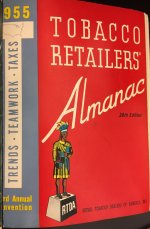
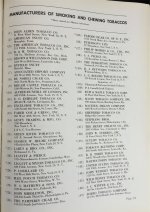
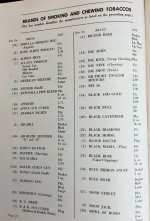
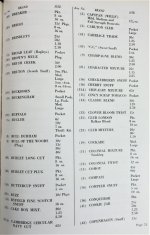

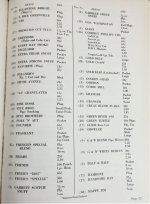
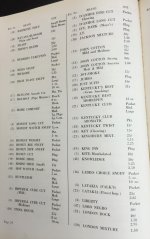







The golden age for pipe tobacco in NZ is still a couple of decades off. It will arrive when I can sit down with my kids and enjoy a bowl together.
Rearly interesting interesting. No Gawith Hoggarth or Sam Gawith. No Escudo. Field & Stream had yet to make an appearance. No Balkan anything.As many people have pointed out in this thread the answer to the OP's question depends on the details of how it's framed. I'm going to dodge the almost jesuitical complexity of this issue (I have enough rabbit holes in my life today, thank you) and simply say that if you take the mid-fifties as a golden age and focus on industry producers as opposed to local tobacconists there were at least 47 manufacturers serving the American market offering in aggregate several hundred brands. The standard industry resource for the US is the annual (more or less) almanac published by what was then called the RTDA (the Retail Tobacco Dealers of America). Unfortunately I don't think this site supports the insertion of a pdf so I'll insert a few images of the relevant part of the 1955 edition. The pages below constitute approximately half of that year's listings; the rest is available for the insatiably curious. Obviously depending on your definition of "golden age" a different year could be selected.
View attachment 235572
View attachment 235573
View attachment 235574
View attachment 235575
View attachment 235576
View attachment 235577
View attachment 235578
Last edited:
I grew up in a suburb immediately adjacent to the corporate city limits of Chicago on the commuter railroad, and right adjacent to the tracks was a pipe shop. I wish I knew the exact years of its operation. It was the Park Ridge Pipe Shop and had a resident artisan pipe carver and did individual blends.
By today's standards, it was advanced. It existed all before the internet. It was a sort of community center for counter culture kids, but that all happened after I started commuting downtown to college and then transferred out-of-state.
But in terms of pipe smoking, that was the local golden age. My dad had been a pipe smoker for all of his adult life, but it was way too fancy for him. He bought his pipes at the newsstand and his Granger at the grocery store. No golden age stuff for him.
By today's standards, it was advanced. It existed all before the internet. It was a sort of community center for counter culture kids, but that all happened after I started commuting downtown to college and then transferred out-of-state.
But in terms of pipe smoking, that was the local golden age. My dad had been a pipe smoker for all of his adult life, but it was way too fancy for him. He bought his pipes at the newsstand and his Granger at the grocery store. No golden age stuff for him.
Today there are few manufacturers although there are many different mixtures. But it is dangerous because there are few manufacturing. But there are also many small-scale manufacturers who, thanks to the WWW, can reach the whole world. What is undoubted is that social networks bring more people to the hobby every day and today there are more smokers than in the 90s and 00s.
Dadgum fat fingers. I mean, "Really interesting."Rearly interesting interesting. No Gawith Hoggarth or Sam Gawith. No Escudo. Field & Stream had yet to make an appearance. No Balkan anything.
Strange to think I have had 24 of the blends on these few pages!As many people have pointed out in this thread the answer to the OP's question depends on the details of how it's framed. I'm going to dodge the almost jesuitical complexity of this issue (I have enough rabbit holes in my life today, thank you) and simply say that if you take the mid-fifties as a golden age and focus on industry producers as opposed to local tobacconists there were at least 47 manufacturers serving the American market offering in aggregate several hundred brands. The standard industry resource for the US is the annual (more or less) almanac published by what was then called the RTDA (the Retail Tobacco Dealers of America). Unfortunately I don't think this site supports the insertion of a pdf so I'll insert a few images of the relevant part of the 1955 edition. The pages below constitute approximately half of that year's listings; the rest is available for the insatiably curious. Obviously depending on your definition of "golden age" a different year could be selected.
View attachment 235572
View attachment 235573
View attachment 235574
View attachment 235575
View attachment 235576
View attachment 235577
View attachment 235578







